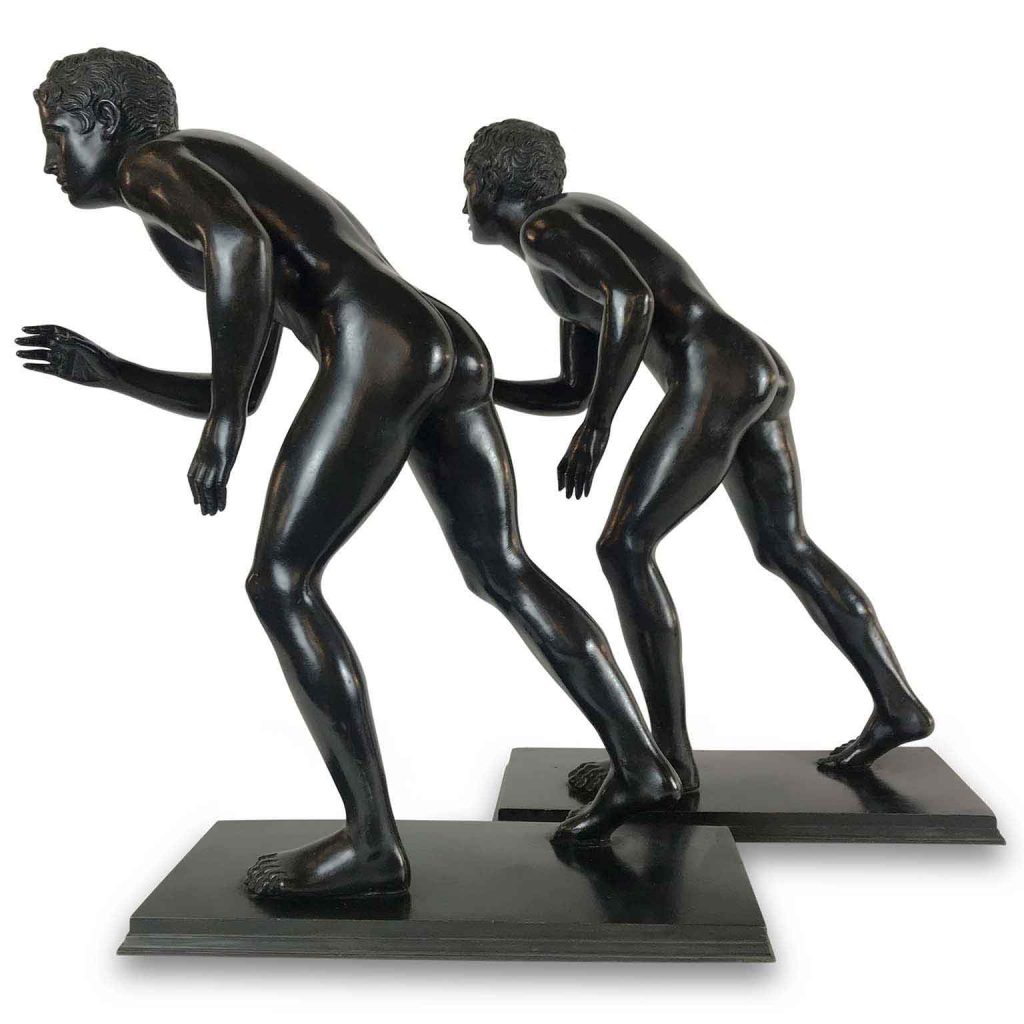Righetti Francesco Borghese Gladiator Rome 1809 19th Century Italian Bronze Sculpture
A stunning Neoclassical Gladiator bronze sculpture signed by the Italian artist Francesco Righetti, (Roma 1749-1819) realized in Rome in 1809.
The bronze represents the famous Greek sculpture of a young fighter portrayed in the act of protecting himself from the aggression of the enemy with the shield which, originally, had to be attached in the sculpture to the left arm raised on guard.
The bronze figure with dark patina rests on a base, which bears the signature F. RIGHETTI F.ROMAE 1809.
The original marble, now in the Louvre museum’s Greek Statuary in Paris, can be dated to the first century BC. and it was discovered near Neptune in 1611, becoming two years later one of the most valuable pieces in the collection of Cardinal Scipione Borghese,from which it took its name. Subsequently, in 1807, it was bought by Napoleone Bonaparte and placed in the Salle d’Apollon at the Musée Napoléon.
The sculpture, particularly appreciated for its timely and true anatomical rendering, caught in its extremely harmonious athletic gesture, was often reproduced in large and small scale since the 17th century.
The perfect translation into bronze of the Gladiator, anatomical perfection of the human body, muscles exaltation and the harmony of the figure, are peculiar characteristics of Righetti’s works.
Besides the high quality casting even captures the expression of terror on his face, as in the original model, make it one of the most important models of Neoclassical sculpture.
Signed and dated on the front pedestal, F. RIGHETTI F. ROMAE 1809, in the back of the base there is a German engraving which certifies the donation of this artwork to an official from Hamburg in 1905.
Righetti was trained in Rome, in the studio of Luigi Valadier’s (1726-1785). His bronze casts were so refined that Catherine the Great and Popes Pius VI and VII were among his patrons. In 1805, he took over from Valadier as head of the Vatican foundry.
His debut on the international scene took place in 1781 with the realization of a series of lead castings, copies of ancient masterpieces and not only, for the villa of the famous banker Henry Hope, in Welgelegen near Haarlem.
Also Righetti soon became famous for his small bronzes taken from ancient statuary, to which he copied copies taken from the masterpieces of Bernini, by Giambologna. During the French Empire, some of Rome’s most illustrious figures commissioned works from him, including Camillo Borghese and his wife Pauline Bonaparte, Napoleon’s sister.
As well as specialising in bronze statuettes, he was renowned for casting monumental sculptures for Antonio Canova, such as the Napoleon I commissioned by Eugène de Beauharnais (Palazzo Brera, Milan).
He later worked for the Court of Naples, executing, together with his son Luigi, the equestrian monuments to Charles III and Ferdinand I in front of the Royal Palace.
Righetti owned a well-known foundry in Rome, where he sold bronze reductions of celebrated Antique statues. In a few years his works were a great success, so much so that the German Alois Hirt, one of the ciceroni most requested among the German travelers to Rome, defined in 1787, Francesco Righetti and his son Luigi, the most famous bronzesmiths who fuse statues from the ancient to small in the city.
In 1794, the Gladiator appeared in a catalogue of bronze statuettes printed by the Roman bronze artist Francesco Righetti (Gladiatore Combattente), Sculpteur & Fondeur en bronze à Rome Rue la Purification à Capo le Case.
His excellent castings of classical models were popular souvenirs for the European aristocracy to bring back from their Grand Tour. He counted important princes and kings, including Pius VI and Empress Catherine II of Russia.
The modern ebonized wooden base, mounted with Neoclassical gilt bronze friezes measures 9,5 cm H by 32,5 cm W. by 17,5 cm D.
Whereas the bronze sculpture only, measures 34.6 cm H by 33 cm W by
20 cm d.
Provenance: Italian Milanese private collection.
The sculpture is in good condition, the bronze has a unique original dark patina, slightly marked closed to the German inscription on the back of base. At the right anterior thigh, the resting leg, a minimal inconsistency is revealed in the junction of the jet of the leg and that of the body.
Period: 1800
Height: 42,6 cm
Width: 38,5 cm
Depth: 22,4 cm
Thanks to agreements with the most important transport companies we are able to deliver within 72 hours from all over Italy!
Each shipment is traceable and insured for the full value!
The attention and care in packaging allow us always to travel the purchased goods with confidence and safety.
Within each package you will find tax records and the object authenticity certificate.
You may also like…
- Distribute: 45,000
- Goal: 70,000
Italian Grand Tour Bronze Runner Sculptures Early 20th Century
- Distribute: 45,000
- Goal: 70,000
Italian 19th Century Bronze Sleeping Venus Sculpture Signed E Sala Marble Base
- Distribute: 45,000
- Goal: 70,000
20th Century Italian Smiling Girl Bust White Marble Sculpture by Bossi Aurelio
- Distribute: 45,000
- Goal: 70,000
Italian Alabaster Gentleman Bust Figure By Tabacchi mid 19th Century
C.C.I.A.A. di Milano – Rea n° 1353105 | P.Iva 09289030158 | Copyright © 2024

















